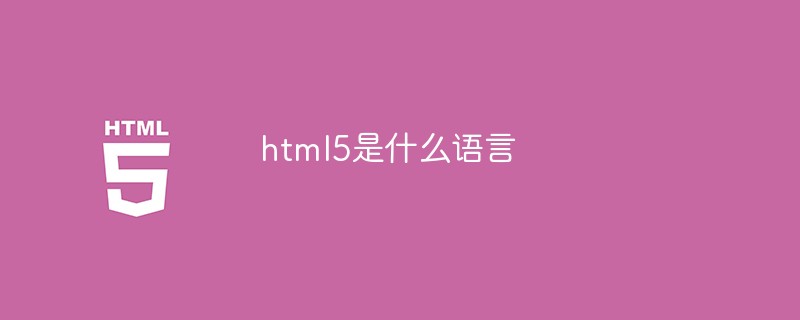Home >Web Front-end >Front-end Q&A >What language is html5?
What language is html5?
- 青灯夜游Original
- 2021-05-17 14:15:525806browse
html5 is a markup language and the fifth major modification of Hypertext Markup Language (HTML). HTML5 is the specification of the core language HTML in the Web. The content that users see when browsing the web using any means is originally in HTML format. It is converted into identifiable information through some technical processing in the browser.

The operating environment of this tutorial: Windows 7 system, HTML5 version, Dell G3 computer.
The full English name of HTML is Hyper Text Markup Language, which is Hypertext Markup Language. HTML5 is a new version of HTML. HTML is not a programming language, but a markup language.
HTML5 is the fifth major revision of Hypertext Markup Language (HTML), an application under Standard Universal Markup Language, the core language of the World Wide Web.
HTML5 is a language description method for constructing web content. HTML5 is the next generation standard of the Internet and a language method for constructing and presenting Internet content. It is considered to be one of the core technologies of the Internet. HTML was created in 1990, and HTML4 became an Internet standard in 1997 and is widely used in the development of Internet applications.
HTML5 is the specification of the core language HTML in the Web. The content that users see when browsing the web using any means is originally in HTML format. It is converted into a recognizable format through some technical processing in the browser. Information. HTML5 has made certain improvements on the basis of the previous HTML4.01. Although technical personnel may not put these new technologies into application during the development process, website development technical personnel must be aware of the new features of this technology. understand.
HTML5 technology combines and innovates the relevant standards of HTML4.01 to meet the requirements of modern network development and was officially released in 2008. HTML5 is made up of different technologies and is widely used on the Internet to provide more standard machines for enhanced web applications. Compared with traditional technologies, HTML5's grammatical features are more obvious and combined with the content of SVG. The use of these contents in web pages can make it easier to process multimedia content, and HTML5 also incorporates other elements to adjust and modify the original functions and standardize them. HTML5 reached a stable version in 2012.
HTML5 Features
-
Semantic Features (Class: Semantic)
HTML5 gives web pages better meaning and structure. Richer tags will come with support for RDFa, microdata and microformats, building a data-driven Web that is more valuable to both programs and users.
-
Local storage features (Class: OFFLINE & STORAGE)
The web APP developed based on HTML5 has shorter startup time and faster network speed, all of which Benefit from HTML5 APP Cache, as well as local storage capabilities. Indexed DB (one of the most important technologies for html5 local storage) and API documentation.
-
Device Compatibility Features (Class: DEVICE ACCESS)
Since the API documentation of the Geolocation function was made public, HTML5 has provided more functional features for web application developers. Optimized selection brings the advantages of more experience functions. HTML5 provides an unprecedented open interface for data and application access. Allows external applications to be directly connected to the data inside the browser, for example, video and audio can be directly connected to microphones and cameras.
-
Connection Features (Class: CONNECTIVITY)
More effective connection efficiency, enabling page-based real-time chat, faster web game experience, and more optimized online Communication is achieved. HTML5 has more effective server push technology. Server-Sent Event and WebSockets are two of the features. These two features can help us realize the function of the server "pushing" data to the client.
-
Web page multimedia features (Class: MULTIMEDIA)
Supports multimedia functions such as Audio and Video on the web page, which complement the website's own APPS, camera, and audio and video functions.
-
Three-dimensional, graphics and special effects features (Class: 3D, Graphics & Effects)
Users will be amazed by the 3D functions based on SVG, Canvas, WebGL and CSS3. Amazing visual effects presented in the browser.
-
Performance and Integration Features (Class: Performance & Integration)
No user will wait forever for your Loading - HTML5 will solve the previous cross-border problem through technologies such as XMLHttpRequest2 Domain and other issues help your web applications and websites work faster in diverse environments.
Recommended tutorial: "html video tutorial"
The above is the detailed content of What language is html5?. For more information, please follow other related articles on the PHP Chinese website!

